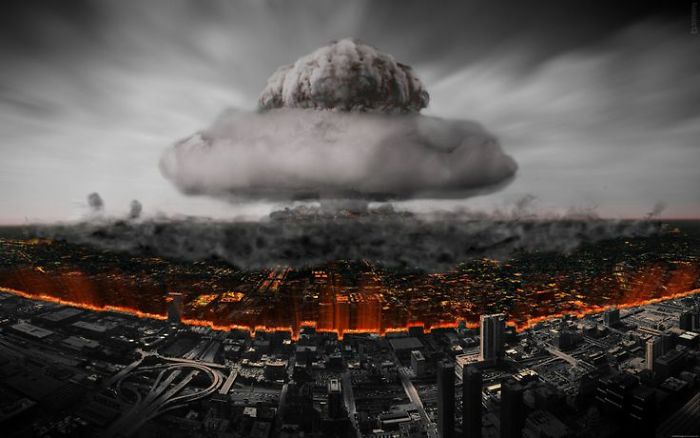5 Disturbing Effects Of A Nuclear Weapon
364views
What are the effects of a nuclear weapon?
If you imagine that a nuclear bomb of 1 megaton is detonated in 2½ kilometers (1.5 miles) altitude over a major city, the immediate effect manifests itself in a flash of light, heat radiation, a shock wave, radioactive radiation and an electromagnetic pulse:
1. The flash
In the moment of the explosion it will create a fireball having a temperature of millions of degrees Celsius. The fireball will be bright as the midday sun, and if you see it in under seven kilometers (4.3 miles) away, you will become blind. If the explosion occurs at a height of less than about 800 m (0.5 miles)., The fireball will within the first few seconds, be transformed into a mushroom cloud. In greater heights, it will only form a whitish cloud.
2. The heat radiation
Approximately one-third of the nuclear bombs energy will be converted into heat radiation at the speed of light, which will burn everything up within a 4 km (2.4 miles) radius by a firestorm. Up till a radius of 12 km (7.4 miles) the heat will cause third-degree burns.
3. The shockwave
About half of the energy is converted into a pressure wave which occurs when the air expands due to the heat. The shockwave growth rate is the speed of sound, and will at a distance of 12 km (7.4 miles) have the strength of a hurricane. The pressure waves effects are divided into four zones:
Zone 1. Radius 4 km (2.4 miles). All buildings completely destroyed. 98% of all people killed.
Zone 2. Radius 4-7 km. (2.4 – 4.3 miles) Concrete Buildings damaged while brick houses destroyed. 50% of the residents are killed, 40% injured.
Zone 3. Radius 7-14 km. (4.3 – 8.7 miles) Extensive structural damage. 5% killed, 45% injured.
Zone 4. Radius 14-21 km. (8.7 – 13 miles) Slight structural damage. 25% wounded, a smaller number of killed.
4. The radioactive radiation
Approximately 15% of the energy is emitted as radiation. One-third of it is emitted immediately, while the rest will be issued later in the form of radioactive fallout. The radioactive rays damage the cells of the body and provide radiation sickness, which can not be cured. In zone 4, the survivors have an increased risk of developing leukemia and cancer.
5. The electromagnetic pulse (EMP)
EMP occurs because gamma rays provide air molecules an electric charge. It is comparable to a very violent lightning that causes an excessive electrical current in antennas, telephone wires, computers and so on. All circuits will melt and electrical equipment paralyzed. EMP seems to have no harmful effect on humans. The area of paralysis, will be dependent on the height of explosion (5).
More info: trendtribe.net
Atomic Bomb
What are the effects of a nuclear weapon?
If you imagine that a nuclear bomb of 1 megaton is detonated in 2½ kilometers (1.5 miles) altitude over a major city, the immediate effect manifests itself in a flash of light, heat radiation, a shock wave, radioactive radiation and an electromagnetic pulse:
1. The flash
In the moment of the explosion it will create a fireball having a temperature of millions of degrees Celsius. The fireball will be bright as the midday sun, and if you see it in under seven kilometers (4.3 miles) away, you will become blind. If the explosion occurs at a height of less than about 800 m (0.5 miles)., The fireball will within the first few seconds, be transformed into a mushroom cloud. In greater heights, it will only form a whitish cloud.
2. The heat radiation
Approximately one-third of the nuclear bombs energy will be converted into heat radiation at the speed of light, which will burn everything up within a 4 km (2.4 miles) radius by a firestorm. Up till a radius of 12 km (7.4 miles) the heat will cause third-degree burns.
3. The shockwave
About half of the energy is converted into a pressure wave which occurs when the air expands due to the heat. The shockwave growth rate is the speed of sound, and will at a distance of 12 km (7.4 miles) have the strength of a hurricane. The pressure waves effects are divided into four zones:
Zone 1. Radius 4 km (2.4 miles). All buildings completely destroyed. 98% of all people killed.
Zone 2. Radius 4-7 km. (2.4 – 4.3 miles) Concrete Buildings damaged while brick houses destroyed. 50% of the residents are killed, 40% injured.
Zone 3. Radius 7-14 km. (4.3 – 8.7 miles) Extensive structural damage. 5% killed, 45% injured.
Zone 4. Radius 14-21 km. (8.7 – 13 miles) Slight structural damage. 25% wounded, a smaller number of killed.
4. The radioactive radiation
Approximately 15% of the energy is emitted as radiation. One-third of it is emitted immediately, while the rest will be issued later in the form of radioactive fallout. The radioactive rays damage the cells of the body and provide radiation sickness, which can not be cured. In zone 4, the survivors have an increased risk of developing leukemia and cancer.
5. The electromagnetic pulse (EMP)
EMP occurs because gamma rays provide air molecules an electric charge. It is comparable to a very violent lightning that causes an excessive electrical current in antennas, telephone wires, computers and so on. All circuits will melt and electrical equipment paralyzed. EMP seems to have no harmful effect on humans. The area of paralysis, will be dependent on the height of explosion (5).
More info: trendtribe.net
Atomic Bomb
364views
Share on Facebook



6
0